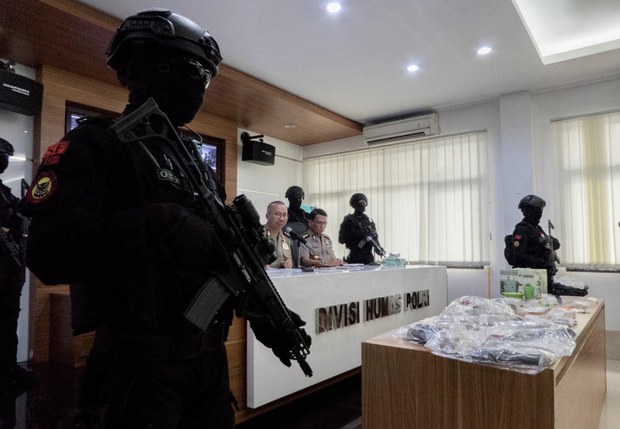Indonesian Terror Groups Get Funding Through Social Media: Govt Report
2017.10.18
Jakarta
 Indonesian anti-terror police stand guard as officials in Jakarta present to the media some evidence seized from suspects in recent militant attacks, June 22, 2017.
Indonesian anti-terror police stand guard as officials in Jakarta present to the media some evidence seized from suspects in recent militant attacks, June 22, 2017.
Indonesian extremist groups have started taking donations via social media, making it tougher for officials to track terrorist financing, government officials confirmed Wednesday.
Funds intended for Islamic State-linked terror networks were formerly channeled through nonprofit organizations, but militant groups shifted their strategy by getting online donations from sympathizers, according to a White Paper report released by the Indonesian government on Wednesday.
“This is due to the development of fundraising trends for terrorist activities and terrorist organizations,” the report said. “In 2013 to 2015, they used nonprofit organizations, now they turn into using social media.”
The report was jointly prepared by the Financial Transaction Reports and Analysis Center (PPATK), the National Counterterrorism Agency (BNPT) and the State Intelligence Agency (BIN).
Before its public release, Gen. Suhardi Alius, commander of the BNPT, told a news conference on Sept. 27 that the White Paper aimed to serve as a guide for government institutions on how to counter terrorism in the county.
“The objective is to review terrorist network mapping and risk mapping,” Kiagus Ahmad Badarudin, the head of PPATK, also said at the conference.
In August last year, PPATK told an international security meeting in Bali that more than U.S. $763,000 was transferred from foreign countries to fund terrorism in Indonesia, between 2014 and 2015.
“They had many ways of sending the funds, for example, through our migrant workers in Malaysia, Singapore and Middle Eastern countries,” PPATK Deputy Chairman Agus Santoso told reporters. “The money can be directed to Indonesia through various countries, such as Australia, Hong Kong, Malaysia, Singapore and many more.”
Indonesia, home to the world’s largest Muslim-majority population, prepared the report in compliance with global efforts to prevent and eradicate money laundering and terror financing, officials said.
Donations via social media and dues from terror-cell members, as well as self-funding are the current preferred financing routes for militants, officials said.
“In this case, social media is used as a means of communication to call for donations,” BNPT deputy commander Brig. Gen. Hamidin told BenarNews.
The new trend of financing via social media marks a major shift from criminal activity, such as motorcycle theft and robbery, which was common in 2013 to 2014 as sources for funding militancy, the report said.
It mapped the funding sources by tracing the pattern of financial transfers and banking transactions related to terror cases that occurred between 2014 and August 2017.
“The shift in the level of risk on remittances is caused by an increase in money coming from abroad aimed at terrorist activities,” the report said.
It said remittance money from Malaysia, Australia and Hong Kong was used to buy weapons from militants in the southern Philippines. It did not provide details.
Indonesia has been wracked by terror attacks targeting police and houses of worship since the 1970s.
Few of them inflicted major casualties, but a bomb attack on Oct. 12, 2002, killed 202 people, including 88 Australians, in the tourist district of Kuta on the island of Bali.
Last year, at least 160 people with alleged ties to Islamic State (IS) were arrested in Indonesia, according to National Police Chief Gen. Tito Karnavian.
In August last year, security ministers from more than 20 countries, including Indonesia, Australia, the United States, England, India and China attended a counter-terrorism meeting in Bali.
The meeting took place amid widespread fears that militant groups were expanding in Southeast Asia, particularly in Indonesia and the Philippines, where a small band of militants are still locked in fighting with government forces in the southern city of Marawi.
The battle, which erupted on May 23, has left more than 1,000 people dead, including 822 militants and 164 Philippine security forces.







